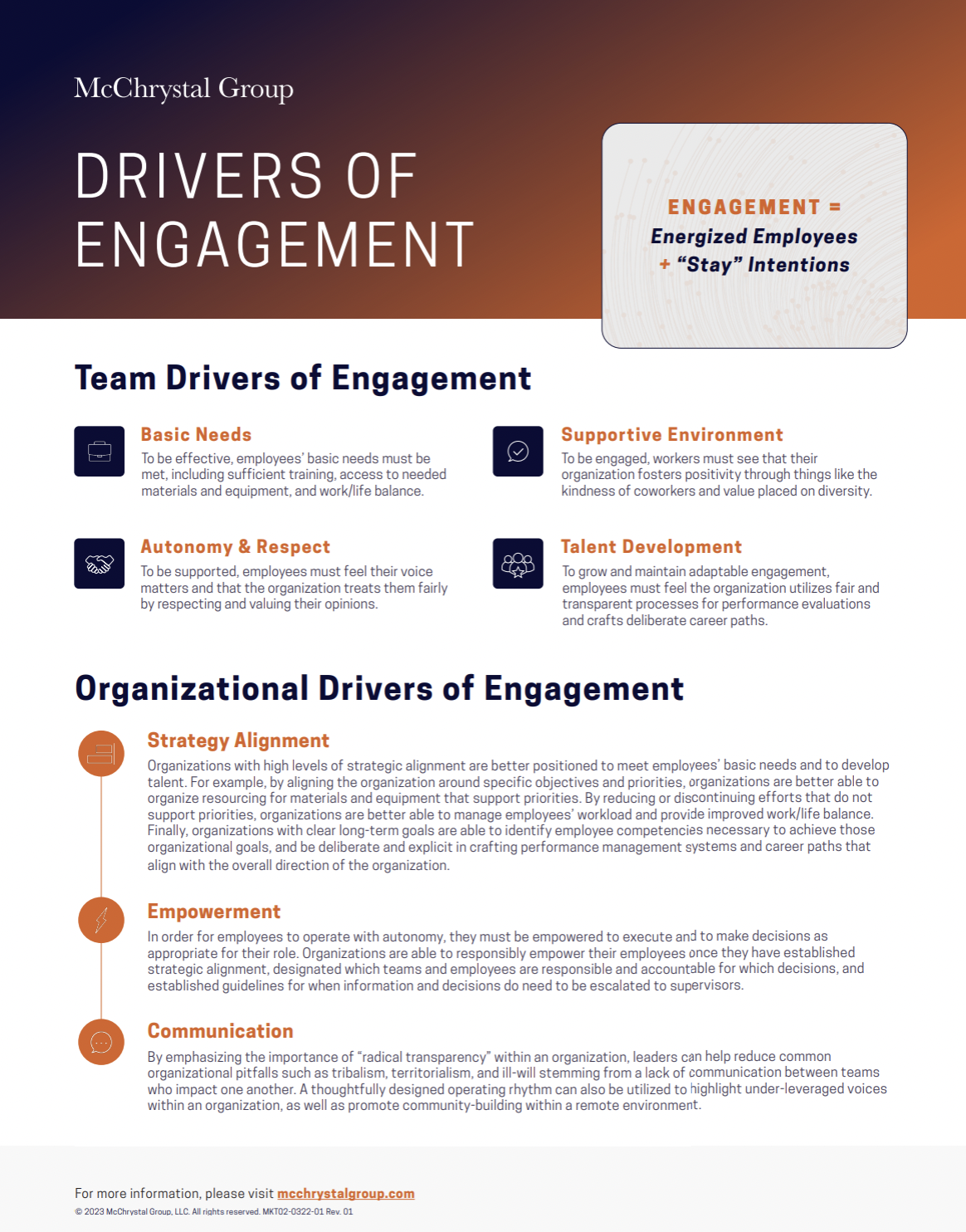The Great Resignation is not a short-term phenomenon. We must examine serious solutions for the tectonic shift in the labor market, as the shaking is far from over. Recent research from SHRM and Microsoft has shown that over 2 in 5 (41%) workers say they are actively searching for a new job or plan to in the next few months.
Replacing people is becoming increasingly challenging and costly, with HR leaders now seeing less qualified people applying for jobs compared to before the pandemic. We also know the Great Resignation is having a negative impact on those who stay behind. This perfect storm of pressures has led to a heightened need for leaders to invest in outpacing the Great Resignation.
Our teammates have spent much of the past two years on the frontlines with our clients, investigating the new reality of the Great Resignation and its implications for leaders and organizations. Our findings are clear: those organizations and, further, those leaders who continually adapt to outpace often-unforeseen risk are those that will succeed. This article is designed to provide the insight and direction you need to remain competitive in an ever-changing landscape that is The Great Resignation.
The Anatomy of The Great Resignation
A record 4 million people quit their jobs in April 2021 starting what has been dubbed the “Great Resignation” period. The statistics since have indicated that this was just the tip of the iceberg. According to SHRM, an all-time record 47.8 million workers quit their jobs in 2021, an average of nearly 4 million each month, and the early months of 2022 have continued at that level with 41% of people still identifying they are actively seeking a new role. A movement of that scale is as complex in its motivations as it is profound in its implications. The multitude of reasons for resignation have been widely cited:
- The opportunity to earn more in a new position, or to enter a new workplace that aligns with a sense of purpose;
- Have more flexibility in work location or return to the office;
- Reduce a commute or move to a new place entirely;
- Move with preferences on corporate positions with issues of social justice, equity, and inclusion.
With multiple driving factors, a solution is necessarily multi-dimensional as well. We have set out to explore the tangible steps you can take to drive retention across your organization that is informed not only by data, but also by the human factor - individuals’ thoughts and motivations – that informs these decisions.
For a look at building teams who are resilient to any external pressure, click here.
Phase One - Detect: Who in your organization, on your team, is most at risk of resignation?
Phase One in your journey to combat this trend is to take an objective inventory of the current state of your team. We recommend that you confront the reality of the shifting priorities of your workforce and speak openly about the reasoning for decisions around topics that may motivate someone to leave their current position – like opportunity for growth or return to the office requirements. Cultivating transparency is key.
After creating clear lines of communication about their goals or any potentially unaligned expectations within your team, leaders must take personal ownership for how those things will be addressed and the downrange implication of them. We recommend leaders invest their time in one-to-one conversations with each of their direct reports to measure their team on a few critical indicators for retention:
- How engaged are they with their team and their work?
- What motivates them? Are those motivators present within the work they are doing?
- Do they feel included?
- Are they clear on their role in achieving the larger mission?
- Have their circumstantial requirements changed in the last year and a half?
Based on these conversations, score the wellbeing of each individual on your team on each of those five categories and notice any common themes or trends that emerge. With that information in hand, you’re ready for Phase Two.
Phase Two - Assess Your Risk: What are your hardest to fill positions and who are your invaluable contributors?
After speaking with individual team members, you should have a better grasp of each individual’s level of engagement and enthusiasm for their work. Assess if a large percentage of your team is unmotivated or disengaged. Seek to understand any personal circumstances that may influence their work - i.e. a relocation during COVID or additional childcare demands. These insights will provide a preliminary blueprint for where your attention and resources should be directed. Ensure you pay close attention to your highest risk quadrant: those who have indicators to be most at risk for departing and who also hold positions that would be difficult to replace should they move on. Prioritize your focus, resources, and action accordingly.
The right course of action from here is unique to your people and organization, but we recommend that the path you pursue needs to include fostering engagement as a core part of its mission. Although employees depart organizations for a number of reasons - in our findings, 40% point to limited career advancement or opportunities to develop as a key motivator in their reasons for leaving - there is strong, singular evidence for why most choose not to:
Engaged employees are 59% less likely to seek out a new job or career in the next 12 months.”
(GALLUP)
McChrystal Group’s research found that high employee engagement, which is defined as employees who are both energized by and invested in their work, is more influential than pay in predicting employees’ intentions to leave their jobs. As was so aptly put in this Inc article – the reality is you cannot buy your people, but you can earn them.
In heeding that lesson, build an engagement action plan with the intention of earning their commitment. Invest in the areas your teammates have identified they need support, and understand that while not one thing motivates every person to leave, providing fulfilling work in an environment that is aligned with their values will increase engagement and thus directly impact their desire to stay.
Phase Three - Respond: Cultivate Engagement in your DNA
We detail the importance of fulfillment and alignment in much of our work as the precursors of engaged teams, and they are measures that you can influence through immediate, low-cost action, and then sustain and develop through longer term investments. In order to build a truly high-performing team, it is critical that fulfillment and alignment are not tossed around in superficial conversations but are ingrained as a part of your team’s DNA.
Fulfillment, our first area of focus, requires that you have a foundation of trust and psychological safety safety, defined in our research as a shared belief held by team members that the team is a safe place for interpersonal risk taking. Building on that foundation, you must demonstrate a culture of inclusion – where each individual feels both valued for their unique contributions and that they belong as a part of the whole. From there you can use tools like engagement and inclusion assessments and inclusion assessments to measure your progress. A few tangible ways to drive team engagement and foster an environment of inclusion include holding team team offsites, providing opportunities for continuing continuing education, and having focused conversations around professional pathways for each individual member of your team. By purposefully investing time and resources in your team, not only do you drive immediate engagement, but you can meaningfully impact their ability to see and desire to pursue a future on your team.
Establishing co-created team norms allows for every person to have a voice in outlining the behaviors that guide how the team interacts and will enable their own optimal engagement.
The development of those norms is something we call cultural alignment and can be an opportunity to cultivate engagement and inclusion itself. Start with setting aside the time as a group to define what you expect of one another behaviorally. That can include:
- How you as a team navigate challenging circumstances and conversations;
- How you can best leverage individual strengths and create space for people to grow in the directions they want;
- What your team needs from you as a leader;
- And what you need from them to achieve specific goals.
We recommend you establish a regular cadence of conversation to evaluate how those established expectations are showing up, impacting your outcomes, and if there are areas you can all improve together. As a note of emphasis, this is something created collectively through discussion and feedback, it should include the voice of every person on the team and as a leader it is your responsibility to ensure that it does.
Seize the Moment
The Great Resignation has proven that the workforce is willing to use action to cast their votes for change. For organizations, the pressures of this moment present an opportunity to drive a permanent shift in how we value our people and conceptualize our investment in them. Strategy, as they say, can only be as good as the individuals we have to execute it. We encourage you to seize this opportunity to cultivate a team poised to achieve their best, further enabling you to achieve yours.
For more leadership resources, please visit our Building Resilient Teams toolkit here.





